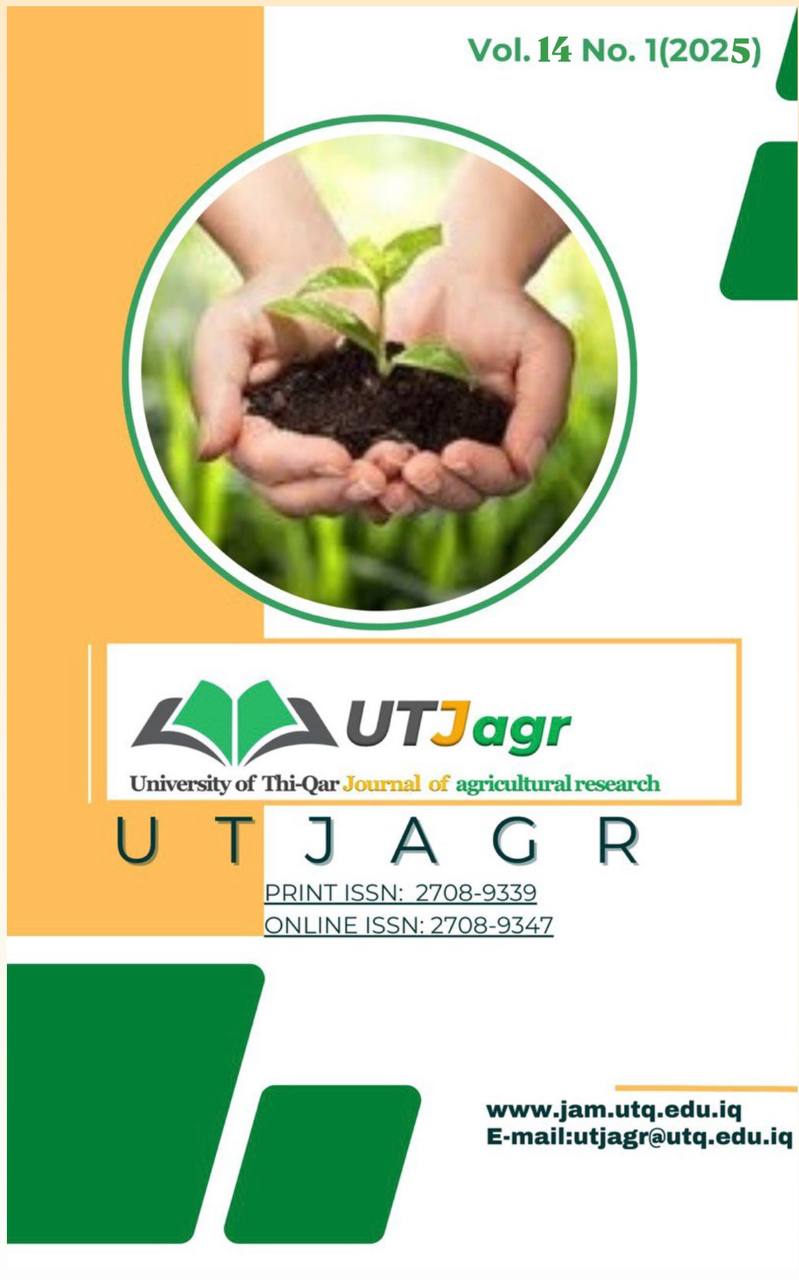Morphological and molecular study of L.cyprinacea In Cyprinus carpio from Aghjalar region in Sulaimani province
DOI:
https://doi.org/10.54174/6g9jkn88Keywords:
Molecular phylogenetics, Lernaeacyprinacea, Cyprinus carpio, 28S rDNA sequencingAbstract
A total of 80 fish (Cyprinus carpio) have been collected from the Aghjalar region in Sulaimani province, Kurdistan region-Iraq . Morphological and light microscopy, as well as the sequencing analysis of (28S rDNA), were used to describe Lernaeacyprinaceain this study. 51 individuals (63.8%) were found to be infested with the ectoparasite Lernaea spp. The overall mean parasite load per infected fish was extremely high, recorded at 14.7 parasites per host, but individuals with even higher numbers of parasites also exist. Molecular analysis results indicate that the PCR product of Lernaeacyprinaceawas 715 bp recorded the highest similarity with (OM835790.1, OM827070.1, OM827069.1, MW423693.1, and MW423694.1) with homology 100%.Our phylogenetic analyses showed that the taxonomic position of the species L. cyprinaceais closely related toLernaeacyprinacea(OM835790.1, OM827070.1, OM827069.1, MW423693.1 and MW423694.1) and Lernaea cruciata(MH982212.1 and MH982215.1). The L. cyprinaceaidentified in our study has the same morphological characteristics as the L. cyprinaceawhich was found for the first time in Iraq.
Downloads
References
• Abdi K. Identification and investigation of crustacean parasites and leeches of fishes of Mahabad Lake. Thesis of D.V.M. Urmia Azad University, 1995; 219: 11-43
• Adams AM. Infestation of Fundulus kinase (Garman) (Pisces: Cyprinodontidae) by the Copepod LernaeacyprinaceaLinnaeus, 1758, in the South Platte River. Am Midl Nat, 1984; 131- 137
• Alishahi M. and Peighan RA. Report of severe and rare infection with Lernaeacyprinaceaein a carp fish. Irani Vet J, 1999; 4: 122-128
• Barson, M., Mulonga, A. and Nhiwatiwa, T. (2008) Investigation of a parasitic outbreak of LernaeacyprinaceaLinnaeus (Crustacea: Copepoda) in fish from Zimbabwe. Afr. Zool., 43(2): 175–183.
• Bilal, M., Abbas, F., Atique, U., Rehman, M. H., Inayat, M., Zohaib, M., ... & Mubeen, N. (2024). Lernaeid parasites are prevalent in commercial freshwater fish species at various fish farms in Pakistan. Brazilian Journal of Biology, 84(e253868), 1–12.
• de Freitas Souza, C. D. F., Baldissera, M. D., Baldisserotto, B., Heinzmann, B. M., Martos-Sitcha, J. A., & Mancera, J. M. (2019). Essential oils as stress-reducing agents for fish aquaculture: A review. Frontiers in Physiology, 10(785), 1–17.
• Des Clers S. Functional relationship between sealworm (Pseudoterranovadecipiens,
Nematoda, Ascaridoidea) Burden and host size in Atlantic cod (Gadus morhua). Proc Biol Sci, 1991; 245: 85-89
• Felsenstein, J. 1985. Confidence limits on phylogenies: An approach using the bootstrap. Evolution, 39: 783.
• Fernando, C.H. (1972) Methods for the Study of Freshwater Fish Parasites. University of Waterloo Biology Series. Department of Biology, University of Waterloo, Canada.
• Gervasoni, S.H., Chemes, S.B., Scaglione, M. and Cerutti, R.D. (2018) First report of Lernaeacyprinacea (Crustacea: Lernaeidae) parasitizing Rhamdiaquelen (Pisces: Heptapteridae) in Santa Fe (Argentina) under hatchery conditions. Rev. Colomb. Cienc. Pecu., 31(3): 229–234.
• Ho J. Cladistics of the Lernaeidae (Cyclopoida), a major family of freshwater fish parasites. J Mar Syst, 1998; 15: 177-183
• Hoffman G. Parasites of North American freshwater fishes. Berkeley and Los Angeles. University of California Press, 1967; 22:11-14
• Hua, C. J., Zhang, D., Zou, H., Li, M., Jakovlić, I., Wu, S. G., ... & Li, W. X. (2019). Morphology is not a reliable taxonomic tool for the genus Lernaea: Molecular data and experimental infection reveal that L. cyprinacea and L. cruciata are conspecific. Parasites & Vectors, 12(1), 579.
• Iqbal, Z., Sajid, M. S., & Muhammad, G. (2012). Lernaea infestation in fish from Punjab, Pakistan: Seasonality, host specificity, and impact on growth. Journal of Parasitology Research, 2012, 1–6.
• Jalali B. and Barzegar M. Fish parasites in Zarivar lake. JAST, 2006; 8: 47-58.
• Jalali B. Lernaeasis in Cyprinid cultured Fish in Iran (Master thesis). University of Godolo, Hungary, 1987; 17
• Jalali B. Parasites and Parasitic Diseases of Iranian Freshwater Fishes. Aquatic Breeding and Rearing. Iranian Fisheries Company, Tehran, 1998; PP: 112-143.
• Jazebizadeh K. Study on parasitic diseases of fishes of Zarivar lake. Environmental Protection Organization of Iran Publication, 1983; PP: 19- 43. (In Persian)
• Kabata, Z. (1985) Parasites and Diseases of Fish Culture in the Tropics. Taylor and Francis, London.
• Kimura, M. 1980. A simple method for estimating the evolutionary rate of base substitutions through comparative studies of nucleotide sequences. J. Mol. Evol., 16: 111
• Kır I. The Effects of Parasites on the Growth of the Crucian Carp (Carassius carassiusL., 1758) inhabiting the KovadaLake. TurkiyeParazitolDerg, 2007; 31: 162-166.
• Klinger RE. and Floyd RF. Introduction to freshwater fish parasites: University of Florida Cooperative Extension Service, Institute of Food and Agriculture Sciences, EDIS; 1998
• Kriswijayanti, B.D., Kismiyati, K. and Kusnoto, K. (2019) Identifikasi dan derajatinfestasiLernaeapada ikan maskoki(Carassius auratus) di kabupatenTulungagung, Jawa Timur (Identification and Degrees of LernaeaInfestation in Goldfish (Carassius auratus) at Tulungagung, East Java). J. Aquac. Fish Health, 3(1): 1–7.
• Lafferty, K. D., &Kuris, A. M. (1999). How environmental stress affects the impacts of parasites. Limnology and Oceanography, 44(3), 925–931.
• Larkin, M. A., Blackshields, G., Brown, N. P., Chenna, R., McGettigan, P. A., McWilliam, H., Valentin, F., Wallace, I. M., Wilm, A., Lopez, R., Thompson, J. D., Gibson, T. J. and Higgins, D. G. 2007. Clustal W and Clustal X version 2.0. Bioinformatics, 23: 2947-2948
• Noga, E. J. (2010). Fish Disease: Diagnosis and Treatment (2nd ed.). John Wiley and Sons.
•
Noga, E.J. (1986) The importance of Lernaeacruciata(Le Sueur) in the initiation of skin lesions in largemouth bass, Micropterus salmoides(Lacepede), in the Chowan River, North Carolina, USA. J. Fish Dis., 9(4): 295–302.
• Noga, E.J. (2010) Fish Disease: Diagnosis and Treatment. 2nd ed. John Wiley and Sons, Iowa, USA.
• Nur, F. M., Batubara, A. S., Fadli, N., Rizal, S., SitiAzizah, M. N., Wilkes, M., &Muchlisin, Z. A. (2022). Lernaeacyprinacea Linnaeus, 1758 (Copepoda: Lernaeidae) infection on Betta Rubra Perugia, 1893 (Anabantiformes: Osphronemidae) from Aceh Province, Indonesia. Revista Brasileira de ParasitologiaVeterinária, 31(1), e020421.
• Nur, F.M., Batubara, A.S., Fadli, N., Rizal, S., SitiAzizah, M.N., Wilkes, M. and Muchlisin, Z.A. (2022) LernaeacyprinaceaLinnaeus, 1758 (Copepoda: Lernaeidae) infection on Betta Rubra Perugia, 1893 (Anabantiformes: Osphronemidae) from Aceh Province, Indonesia. Rev. Bras. Parasitol. Vet., 31(1): e020421.
• Piasecki, W., Goodwin, A. E., Eiras, J. C., & Nowak, B. F. (2004). Importance of Copepoda in freshwater aquaculture. Zoological Studies, 43(2), 193–205.
• Piasecki, W., Goodwin, A. E., Eiras, J. C., & Nowak, B. F. (2004). Importance of Copepoda in freshwater aquaculture. Zoological Studies, 43(2), 193–205.
• Rahman, M. M., et al. (2020). Impact of anchor worms (Lernaea spp.) on aquaculture and control strategies. Aquaculture Reports, 18, 100523.
• Saitou, N. and Nei, M. 1987. The neighbor-joining method: A new method for reconstructing phylogenetic trees. Mol. Biol. Evol., 4: 406
• Sayyadzadeh G., Esmaeili HR., Ghasemian S., Mirghiyasi S., Parsi B., Zamanpoore M., et al. Co-invasion of anchor worms Lernaeacyprinacea (Copepoda: Lernaeidae) in some freshwater shes of the Kor River Basin, Southwest of Iran with some remarks on the ecological aspects of lernaeosis in the country. Iran. J Fish Sci, 2016; 15(1): 369-389
• Soares, I. A., Salinas, V., del Ponti, O., Mancini, M. A., & Luque, J. L. (2018). First molecular data for Lernaeacyprinacea (Copepoda: Cyclopoida) infesting Odontesthesbonariensis, a commercially important freshwater fish in Argentina. Revista Brasileira de ParasitologiaVeterinária, 27(1), 105–108.
• Song, Y., Wang, G. T., Yao, W. J., Gao, Q., & Nie, P. (2008). Phylogeny of freshwater parasitic copepods in the Ergasilidae (Copepoda: Poecilostomatoida) based on 18S and 28S rDNA sequences. Parasitology Research, 102(2), 299–306.
• Soylu, E., 2005. Metazoan Parasites of Catfish (Silurusglanis, Linnaeus, 1758) from Durusu (Terkos) Lake. Journal of Black Sea/Mediterranean Environment, 11(2), pp.225-237.
• Tamura, K., Peterson, D., Peterson, N., Stecher, G., Nei, M. and Kumar, S. 2011. MEGA5: Molecular evolutionary genetics analysis using maximum likelihood, evolutionary distance,and maximum parsimony methods. Molecular Biol. Evol.,28: 2731-2739.
• Woo, P. and Shariff, M. (2006).LerneacyprinaceaL. (Copepoda: Caligidea) in HelostomatemminckiCuvier and Valenciennes: The dynamics of resistance in recovered and naive fish. J. Fish Dis., 13(6): 485–493.
• Zhu, X., Barton, D. P., Wassens, S., & Shamsi, S. (2021). Morphological and genetic characterization of the introduced copepod Lernaeacyprinacea Linnaeus (Cyclopoida: Lernaeidae) occurring in the Murrumbidgee catchment, Australia. Marine and Freshwater Research, 72(6), 876–886.

Downloads
Published
Issue
Section
License
Copyright (c) 2025 Nazanin

This work is licensed under a Creative Commons Attribution-NonCommercial-ShareAlike 4.0 International License.







1.png)

